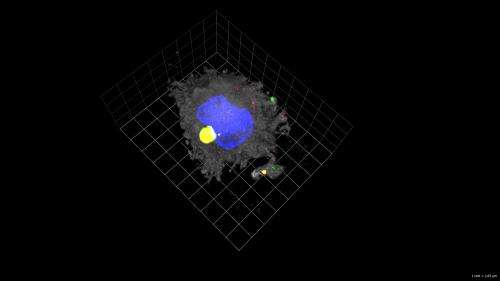Scientists discover how HIV virus gains access to carrier immune cells to spread infection

Scientists from the AIDS Research Institute IrsiCaixa have identified how HIV, the virus that causes AIDS, enters the cells of the immune system enabling it to be dispersed throughout an organism. The new study is published December 18 in the open access journal PLOS Biology.
One of the reasons why we do not yet have a cure for HIV infection is that the virus infects cells of the immune system that would normally fight such an infection. The main targets of HIV are white blood cells named CD4 T lymphocytes (so called because they have the protein CD4 in their membrane), and while more than 20 different drugs are available today to help control HIV, all of them act by blocking the cycle that HIV follows to infect these CD4 T lymphocytes. However, these treatments do not fully act on another cell of the immune system, the dendritic cell, which takes up HIV and spreads it to target CD4 T lymphocytes.
Mature dendritic cells are responsible for activating an immune response by CD4 T lymphocytes, but when they carry viruses, their contact with T lymphocytes causes the virus to be passed on, thus increasing viral spread.
The results continue the research led by ICREA researchers at IrsiCaixa, Javier Martínez-Picado, and Nuria Izquierdo-Useros, in collaboration with research groups from Heidelberg University, Germany, and the University of Lausanne, Switzerland. This team published a previous PLOS Biology paper in April 2012, in which they identified molecules, called gangliosides, located on the surface of HIV that are recognized by dendritic cells and are necessary for viral uptake. The new results now identify a molecule on the surface of dendritic cells that recognizes and binds the gangliosides and allows HIV to be taken up by dendritic cells and transmitted to its ultimate target: T lymphocytes.
"We have observed that the protein that acts as a lock for the entrance of HIV could also facilitate the entrance of other viruses," explains Nuria Izquierdo-Useros. "Therefore, our results could also help us understand how other infections might exploit this mechanism of dispersion."
In order to identify the precise molecule located on the membrane of the dendritic cells capable of capturing HIV, the researchers studied one family of proteins that are present on the surface of these cells, called Siglecs. It is known that these proteins bind to the gangliosides on the HIV surface. In the laboratory, they mixed the virus with dendritic cells that displayed different quantities of Siglec-1, and found that a higher quantity of Siglec-1 led to those dendritic cells capturing more HIV, which in turn allowed for enhanced transmission of HIV to CD4 T lymphocytes, a process called trans-infection.
The team then tried inhibiting the Siglec-1 protein. Doing so in the laboratory, they found that the dendritic cells lost their capacity to capture HIV and, importantly, they also lost their ability to transfer HIV to CD4 T lymphocytes. With all these data, the scientists concluded that Siglec-1 is the molecule responsible for HIV entrance into the dendritic cells, and could therefore become a new therapeutic target.
"We had the key and now we have found a lock," explains Javier Martínez-Picado. "Now we are already working on the development of a drug that could block this process to improve the efficacy of the current existing treatments against AIDS".
More information: Izquierdo-Useros N, Lorizate M, Puertas MC, Rodriguez-Plata MT, Zangger N, et al. (2012) Siglec-1 Is a Novel Dendritic Cell Receptor That Mediates HIV-1 Trans-Infection Through Recognition of Viral Membrane Gangliosides. PLoS Biol 10(12): e1001448. doi:10.1371/journal.pbio.1001448















